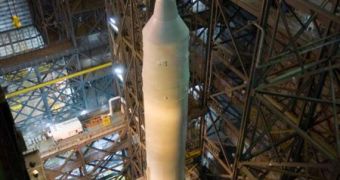According to experts at the American space agency, the test flight of ARES I-X, the prototype of NASA's new Moon rocket, has been targeted for October 27, a full four days earlier than the original date, of October 31st. Officials made the announcement on Tuesday, and said that the demonstration booster for the ARES I delivery system would take off from Launch Pad 39B, at the Kennedy Space Center. The pad is now under Project Constellation, and has been so ever since the space shuttle Atlantis returned from its fifth and final servicing mission to the Hubble Space Telescope, in late May, Space reports.
The launch would take place on Tuesday, at around 8:00 am EDT (1200 GMT), the spokesperson said. One of the reasons why moving the launch ahead of schedule became possible was the fact that engineers working to set up the booster finished their job earlier than predicted. “They are doing a launch countdown simulation today. That's ongoing as we speak,” NASA spokesperson Amber Philman said yesterday. In the coming weeks, the official added, review panels would meet to assess the feasibility of the current launch target.
Engineers working on ARES I-X had a full two weeks ahead of their planned schedule, and said repeatedly that they would use the extra time to troubleshoot any potential flaws that might appear with the rocket. However, in the end, four of the 14 days were not needed, so the launch itself was moved ahead. This is a very rare occurrence, as lift-off sequences are usually pushed back and delayed, and not the other way around. ARES I-X was originally scheduled for launch in July, but the deadline could not be respected. The same thing happened with an August launch date.
The new Ares I-X rocket would be rolled out to its KSC pad on October 19th, the same spokesperson announced. The finishing touches on the refurbished launch facility will be completed next week. Pad 39B had to be converted from a structure supporting the shuttle and its external fuel tanks to one that could accommodate a much taller and thinner delivery system, like the ARES I. However, in spite of the planned test, the faith of ARES I is still uncertain, as evidenced by the guidelines published in the NASA review panel report by experts who investigated the space agency for a couple of months.

 14 DAY TRIAL //
14 DAY TRIAL //